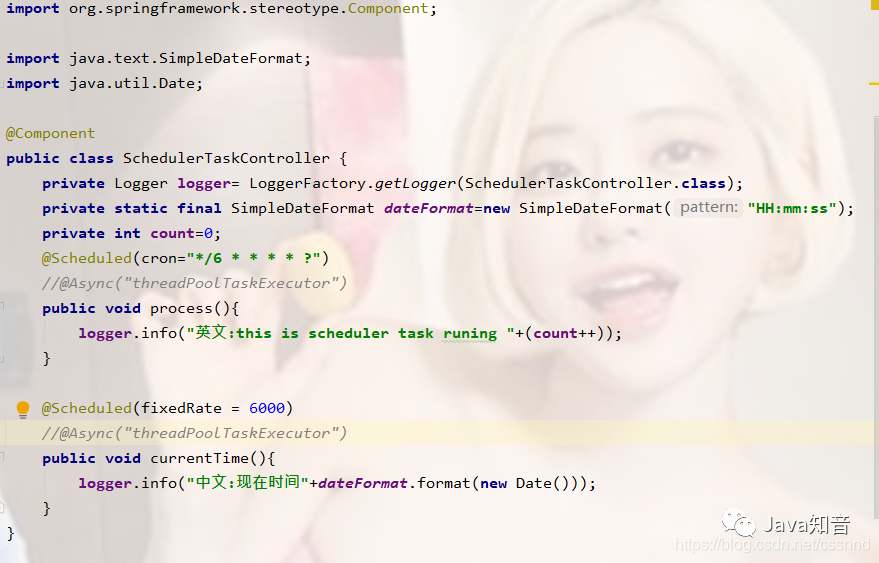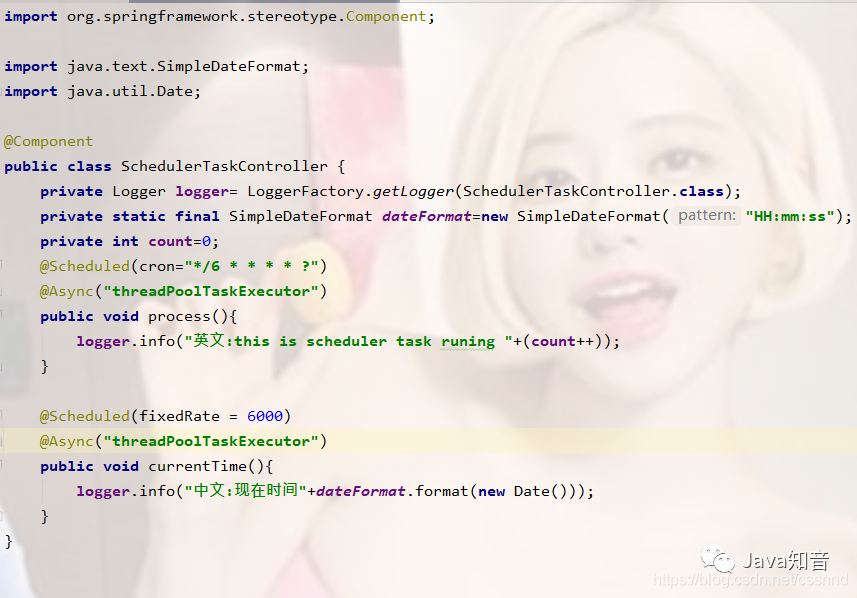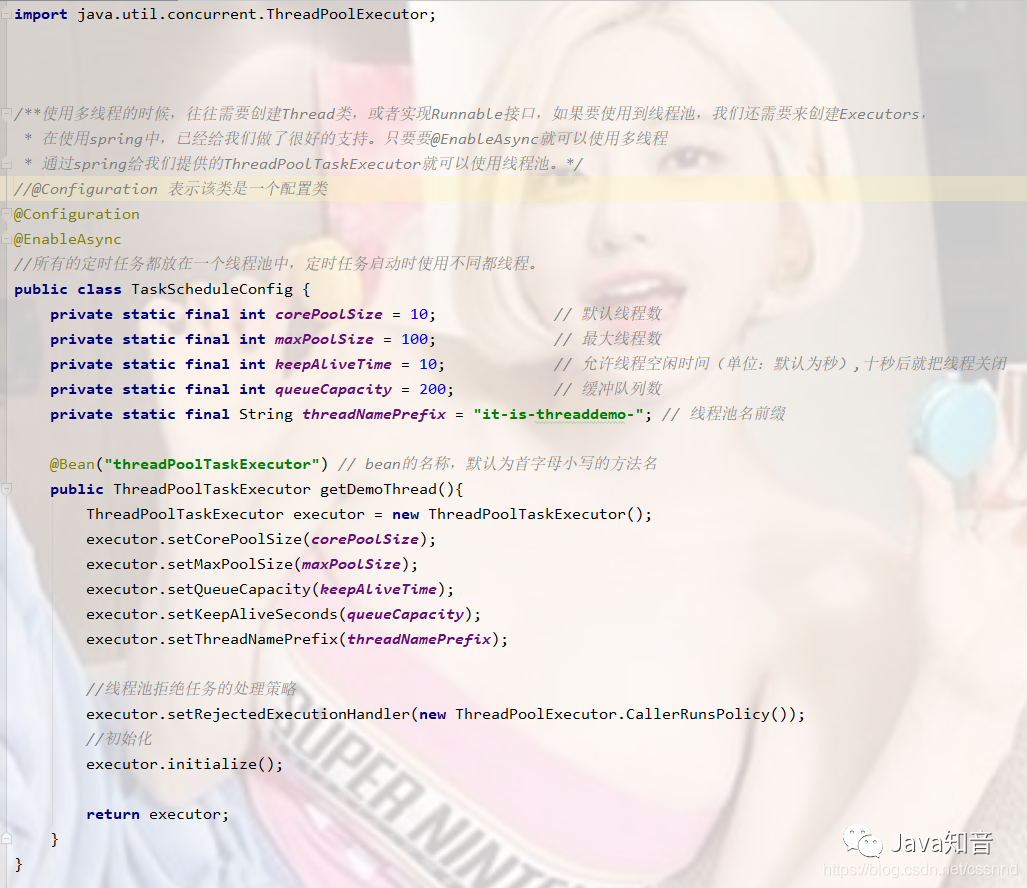SpringBoot多线程环境下,解决多个定时器冲突问题

来源:blog.csdn.net/cssnnd/article/details/108328942
战术分析:
实际开发项目中一定不止一个定时器,很多场景都需要用到,而多个定时器带来的问题 : 就是如何避免多个定时器的互相冲突
使用场景 :
我们的订单服务,一般会有一个待支付订单,而这个待支付订单是有时间限制的,比如阿里巴巴的订单是五天,淘宝订单是一天,拼多多订单是一天,美团订单是15分钟…
基金系统中,如何同时更新多个存储分区中的基金信息…
总的来说,实际开发中定时器需要解决多个定时器同时并发的问题,也要解决定时器之间的冲突问题
问题不大,说到并发那就离不开多线程了…慢慢看看就懂了
问题场景重现 :


我们清晰的看到执行结果都是scheduling-1
就此可以判定,Springboot定时器默认的是单线程的
但是问题就来了,如果在线程争夺资源后,某个线程需要比较长时间才能执行完,那其他的定时器怎么办,都只能进入等待状态,时间越久,累计等待的定时器越多,这就容易引起雪崩…
其实只需要添加一个配置类然后加注解就可以解决问题了
添加注解

具体代码如下 :
import org.slf4j.Logger;
import org.slf4j.LoggerFactory;
import org.springframework.scheduling.annotation.Async;
import org.springframework.scheduling.annotation.Scheduled;
import org.springframework.stereotype.Component;
import java.text.SimpleDateFormat;
import java.util.Date;
@Component
public class SchedulerTaskController {
private Logger logger= LoggerFactory.getLogger(SchedulerTaskController.class);
private static final SimpleDateFormat dateFormat=new SimpleDateFormat("HH:mm:ss");
private int count=0;
@Scheduled(cron="*/6 * * * * ?")
@Async("threadPoolTaskExecutor")
public void process(){
logger.info("英文:this is scheduler task runing "+(count++));
}
@Scheduled(fixedRate = 6000)
@Async("threadPoolTaskExecutor")
public void currentTime(){
logger.info("中文:现在时间"+dateFormat.format(new Date()));
}
}
配置类如下 :

具体代码如下 :
import org.springframework.context.annotation.Bean;
import org.springframework.context.annotation.Configuration;
import org.springframework.scheduling.annotation.EnableAsync;
import org.springframework.scheduling.concurrent.ThreadPoolTaskExecutor;
import java.util.concurrent.ThreadPoolExecutor;
/**使用多线程的时候,往往需要创建Thread类,或者实现Runnable接口,如果要使用到线程池,我们还需要来创建Executors,
* 在使用spring中,已经给我们做了很好的支持。只要要@EnableAsync就可以使用多线程
* 通过spring给我们提供的ThreadPoolTaskExecutor就可以使用线程池。*/
//@Configuration 表示该类是一个配置类
@Configuration
@EnableAsync
//所有的定时任务都放在一个线程池中,定时任务启动时使用不同都线程。
public class TaskScheduleConfig {
private static final int corePoolSize = 10; // 默认线程数
private static final int maxPoolSize = 100; // 最大线程数
private static final int keepAliveTime = 10; // 允许线程空闲时间(单位:默认为秒),十秒后就把线程关闭
private static final int queueCapacity = 200; // 缓冲队列数
private static final String threadNamePrefix = "it-is-threaddemo-"; // 线程池名前缀
@Bean("threadPoolTaskExecutor") // bean的名称,默认为首字母小写的方法名
public ThreadPoolTaskExecutor getDemoThread(){
ThreadPoolTaskExecutor executor = new ThreadPoolTaskExecutor();
executor.setCorePoolSize(corePoolSize);
executor.setMaxPoolSize(maxPoolSize);
executor.setQueueCapacity(keepAliveTime);
executor.setKeepAliveSeconds(queueCapacity);
executor.setThreadNamePrefix(threadNamePrefix);
//线程池拒绝任务的处理策略
executor.setRejectedExecutionHandler(new ThreadPoolExecutor.CallerRunsPolicy());
//初始化
executor.initialize();
return executor;
}
}
然后我们可以很清晰地看到

如上,也就解决了用多线程解决Springboot多定时器冲突的问题
PS:因为公众号平台更改了推送规则,如果不想错过内容,记得读完点一下“在看”,加个“星标”,这样每次新文章推送才会第一时间出现在你的订阅列表里。点“在看”支持我们吧!
评论
